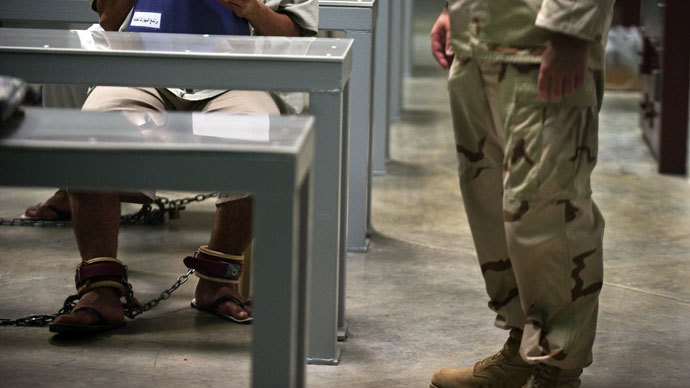Article 5 of the UN Declaration of Human Rights expressly forbids that any person “be subjected to torture or to cruel, inhuman or degrading treatment or punishment.”
When then-Senator and presidential candidate Barack Obama promised to end torture, close the Guantanamo Bay gulag and restore habeas corpus, he was speaking to a fundamental desire within the American public consciousness to restore the ideals upon which the United States is based – ideals which had been all but discarded under the Bush administration.
Americans wanted an end to CIA torture sites, an end to “enhanced interrogation” and an end to arbitrary and indefinite detention. Once elected, President Obama did his best to present the appearance that the country had restored its humanity by signing Executive Order #13,491, effectively ending the “enhanced interrogation” policies enacted under George W. Bush.
Yet the United States, under both the Bush and Obama administrations, has engaged in systematic torture and inhuman treatment in blatant violation of international law. Buried in the text of Obama’s Executive Order was the condition that, “an individual in the custody…of the United States Government…shall not be subjected to any interrogation technique or approach, or any treatment related to interrogation, that is not authorized by and listed in Army Field Manual 2 22.3.” Essentially then, the Obama administration began its first term of office by sanctioning the use of the Army Field Manual and the standards, protocols and methods of interrogation outlined within it. Rather than officially ending the torture practices implemented during the Bush years, Obama simply put an end to certain egregious methods while validating others.
As the Center for Constitutional Rights noted at the time: “While the current Army Field Manual does not allow waterboarding, it does include approved techniques that constitute torture.” Some of these techniques are outlined in the infamous Appendix M of the field manual which describes the use of “Separation” which is applied to the ambiguously termed “unlawful combatants” who, because of their status as something other than prisoners of war, are subjected to gross violations of international law. Appendix M describes techniques such as prolonged isolation, sleep deprivation, sensory deprivation and the use of fear and humiliation of prisoners. And yet Obama claims to have “ended torture.”
It should be noted also that, instead of pushing for strict anti-torture legislation that would have codified policies against the use of “enhanced interrogation,” Obama chose to issue an executive order that can be reversed with the stroke of a pen from any future president. Moreover, the he chose to limit the scope of the order in order to provide political wiggle-room for himself in case he was seen as “soft on terror.” It is within this context that one should remember that, despite his promises, Guantanamo Bay remains open, rendition programs continue and not one person from the CIA or any other agency has ever been held to account for their myriad crimes. As Obama said in 2009 “[I have a] belief that we need to look forward as opposed to looking backwards…at the CIA you’ve got extraordinarily talented people who are working very hard to keep Americans safe. I don’t want them to suddenly feel like they’ve got to spend all their time looking over their shoulders.”

In 2013, the non-partisan Constitution Project issued a report that, among other things, documented in painstaking detail many of the ways in which the Obama administration has cleverly manipulated and ignored the laws, not to mention Obama’s campaign promises, in order to continue the torture and rendition programs. The report noted: “Taken as a whole, the lack of successful prosecutions demonstrates major gaps in enforcement of the laws against torture and war crimes, which likely reduces their deterrent effect.” Essentially then, the current administration, by turning a blind eye to crimes committed by interrogators under Bush as well as Obama, has effectively negated any perceived anti-torture stance it might have taken.
While the president has managed, through rhetoric and spin, to keep up the appearance that he has put a stop to torture when it comes to the so-called “War on Terror,” he has maintained a deafening silence when it comes to torture at home.
Torture and the American Gulag
Despite managing to lecture countries such as Russia, China and Cuba for human rights abuses and political prisoners, the United States continues to be, by far, the greatest police state in the world. With only 5 percent of the world’s population, the US has 25 percent of the world’s prison population. Within this pervasive prison-industrial complex, many thousands of prisoners are held in extended solitary confinement, which undoubtedly constitutes torture. In fact, United Nations Special Rapporteur on Torture Juan E. Mendez stated in 2011:
“Segregation, isolation, separation, cellular, lockdown, Supermax, the hole, Secure Housing Unit… whatever the name, solitary confinement should be banned by states as a punishment or extortion technique… Solitary confinement is a harsh measure which is contrary to rehabilitation, the aim of the penitentiary system... Considering the severe mental pain or suffering solitary confinement may cause, it can amount to torture or cruel, inhuman or degrading treatment or punishment when used as a punishment, during pre-trial detention, indefinitely or for a prolonged period, for persons with mental disabilities or juveniles.”
It should of course be noted that, like the prison population in general, solitary confinement is disproportionately applied to people of color. More to the point, it is most often utilized to break the mind, body and spirit of political prisoners, especially those from civil rights and radical political movements. So, if the president were actually interested in putting an end to torture, not to mention paying attention to the issues most directly affecting people of color in the US, wouldn’t it stand to reason that he might have something to say about this abhorrent practice in the US prison system? Obama meets such questions with silence.
Did you think that the United States only operated secret prisons abroad? If so, you’d be wrong. Under the Obama administration there has been an expansion of the use of so called “Communication Management Units” (CMUs) – secret prisons specifically designed to house political prisoners in isolation and in blatant violation of their constitutional rights. Prisoners of Middle Eastern descent, animal rights activists, environmental activists and others have found themselves locked up in CMUs with little to no contact with family and/or their legal representatives. Naturally, the President has never spoken on this issue as it would once again fly in the face of the picture of the constitutional scholar-cum-president and his image as a defender of human rights.
There has been resistance to these inhuman policies carried out by the United States. In Guantanamo, the world watched as a number of prisoners risked their lives in a prolonged hunger strike to call attention to their continued illegal imprisonment. Similarly, recent hunger strikes in US prisons, most notably at California’s infamous Pelican Bay prison, have attempted to focus media attention and public scrutiny on the continued torture of inmates. Luis Esquivel, an inmate at Pelican Bay, succinctly illustrated the point when he said: “I feel dead. It’s been 13 years since I’ve shaken someone’s hand and I fear I’ll forget the feel of human contact.”
Whether engaging in systematic torture abroad or at home, the United States continues to be a world leader in this regard. Despite the rhetoric from President Obama, substantive changes have not been made to the way in which the US treats its prisoners, nor to the rights afforded them. Indeed, despite the high-minded ideals Obama espouses in speech after speech, the sad reality is that, like Bush before him, Obama is the figurehead of the most aggressive and repressive power in the world today.
The statements, views and opinions expressed in this column are solely those of the author and do not necessarily represent those of RT.
The statements, views and opinions expressed in this column are solely those of the author and do not necessarily represent those of RT.


